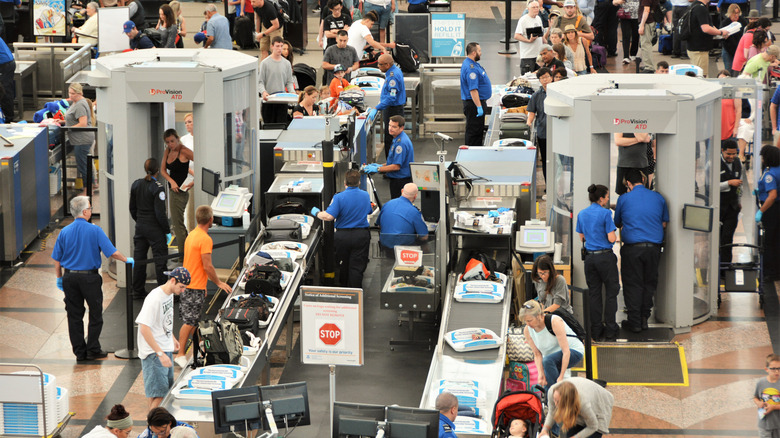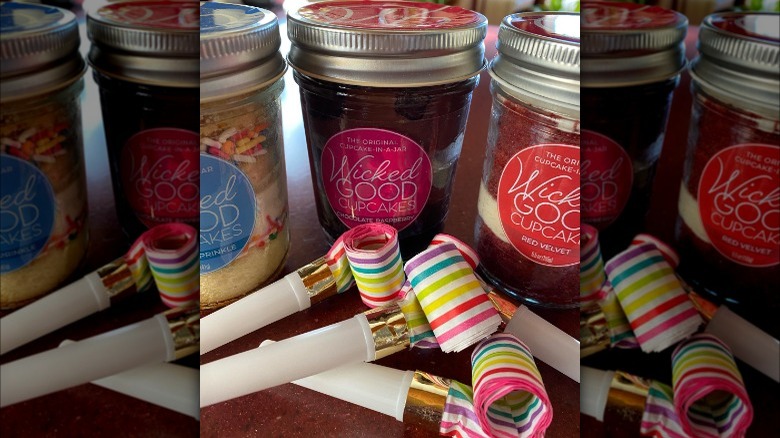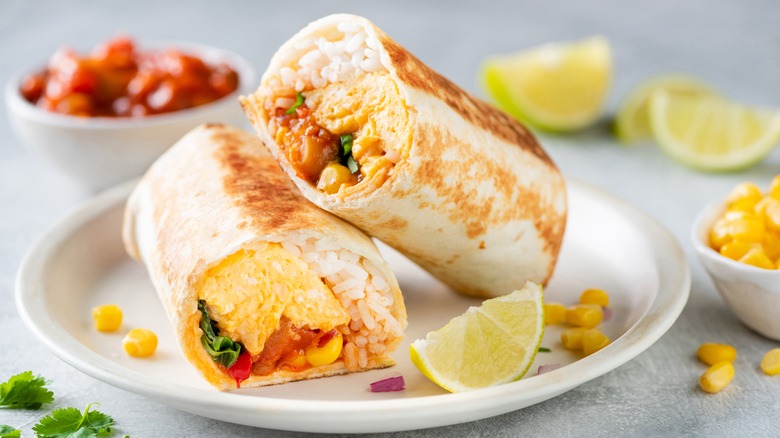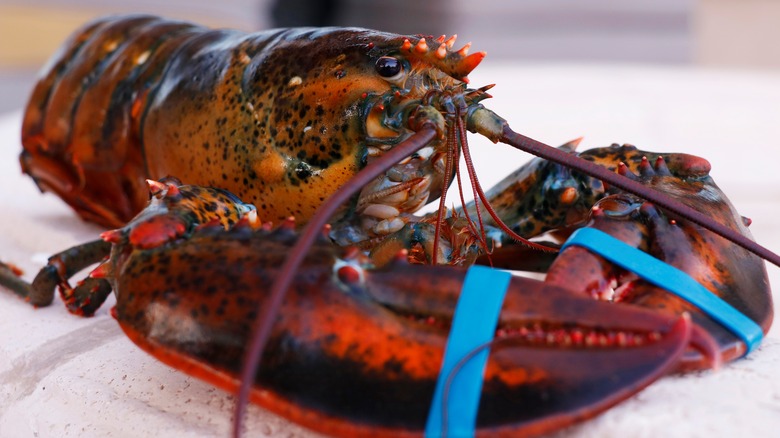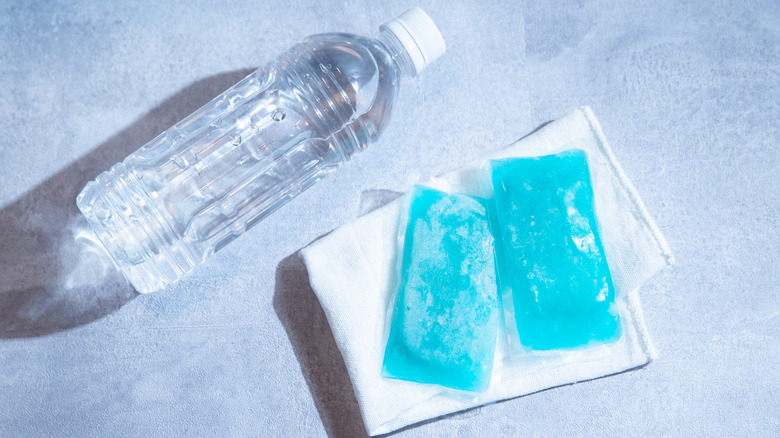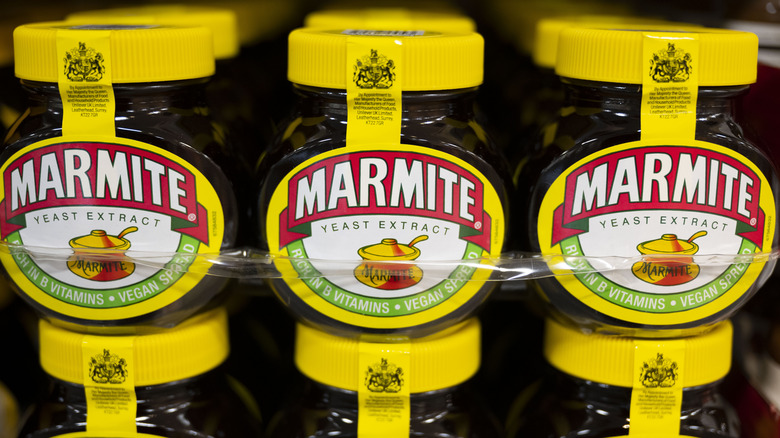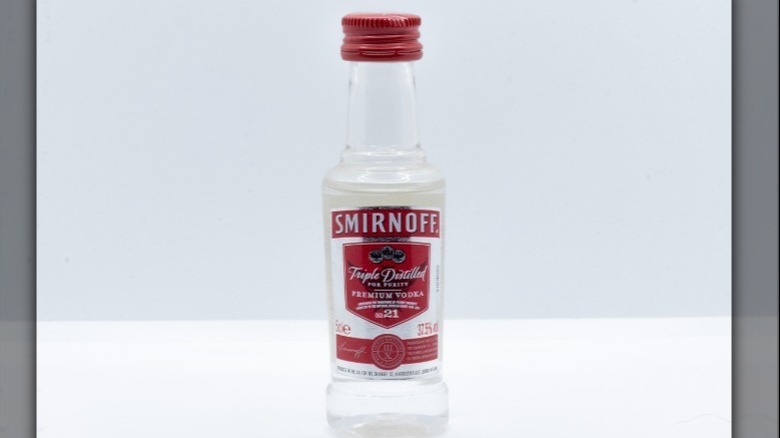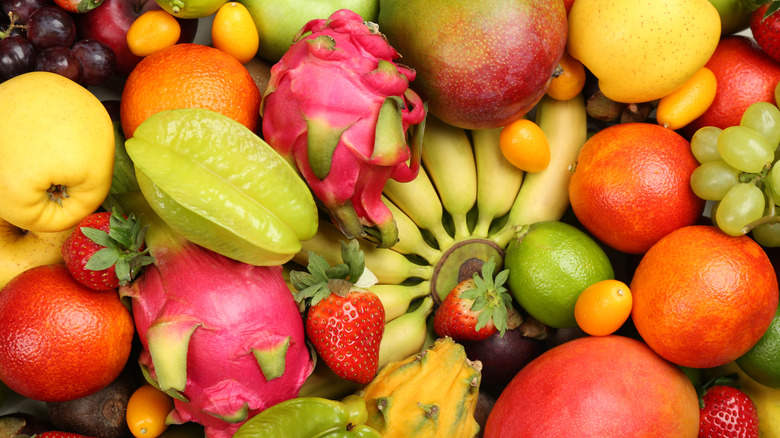9 Foods You Shouldn't Try To Get Past Airport Security
If you're traveling, there's a good chance that at some point you may find yourself in the dreaded TSA line. While it can be a hassle to get through security, it may come as a surprise that you can bring food through the airport and onto the plane. Bringing food on your journey can be lovely — after all, those jokes about airline food have to come from some place of truth.
When it comes to your in-flight snacks, there's no shortage of combos to bring with you on board. But, for all the foods that are allowed, there are just as many that are likely to be confiscated at the checkpoint. A good rule of thumb to keep in mind when packing food is that most solids are allowed, while containers of liquids are strictly limited to no more than 3.4 ounces in volume, per the TSA.
Tight requirements such as those have led to viral moments in travel news, such as one woman who chugged a bottle of Rémy Martin Cognac rather than release it to airport security (via Vice). This was a bit of a last-ditch effort, given that the TSA, for example, allows passengers to either check or mail belongings that are confiscated, if there's enough time before boarding. Nonetheless, to save some heartache, and some hunger, here are some foods that won't make it past the checkpoint.
1. Creamier cheeses
Brie, Neufchâtel, ayib ... There's no shortage of gorgeous cheeses around the world. Unfortunately, some of them won't make it from your vacation spot back home. Hard cheeses, such as, say, Jarlsberg or cheddar, are definitely solid and can be brought in a checked bag with absolutely no limit. According to Still Tasty, soft and spreadable cheeses, however, fall under the TSA's 3-1-1 rule. For those unfamiliar, the 3-1-1 rule is a good measurement that, per the TSA, roughly translates to the absolute limit of liquids in flight: 3.4 ounces or 100 milliliters in a 1-quart bag.
This means that while soft cheeses can technically be brought on board, they must measure under 3.4 ounces and contribute to the passenger's overall liquid allowance. While the American TSA has not listed any reason as to why soft cheese is treated as a liquid, it can be inferred from the U.K.-based Express that the reasoning lies in the fact that these cheeses are already soft to the touch and melt very quickly and liquify.
2. Cupcakes in a jar
For a very long time, cupcakes had the world in a chokehold. After all, what could be better than a bite-sized piece of heaven? It seemed that there was no end to our boundless love for these miniature cakes, from boutique cupcake shops, to mini-cupcakes, to even the return of the cupcake to the cup, or rather jar. Popularized by Massachusetts-based Wicked Good Cupcakes on the hit show "Shark Tank," cupcakes in a jar are the equivalent of two cupcakes with oodles of different fillings and toppings contained in one jar (via Wicked Good Cupcakes). They're pretty, contained, and, for the more travel-minded, perfect for flights! That is, of course, without TSA regulations.
In 2012, NPR reported on an incident that was dubbed "cupcakegate," in which an airline passenger's cupcake in a jar was confiscated by the TSA before her flight the previous year. The internet went into a fervor — what's the sense in allowing cupcakes through security, but not cupcakes in a jar? NPR quotes a since-deleted blog post by the TSA defending their choice, based on the amount of icing that a cupcake in a jar has. Because there's more icing, cupcakes in a jar potentially violate the 3-1-1 rule. The agency did concede that cakes and pies are theoretically allowed through security, albeit as their own carry-on. The caveat? It still remains up to the individual TSA agent to decide whether or not the sweet treat is making the flight.
3. Salsa and hot sauces
Who doesn't love keeping it spicy, and what better way than in a burrito? Burritos remain one of the staples and stars in American cuisine. There are probably few foods that work so well when travelling and pack a better punch: They're loaded with grain, protein, and vegetables. They're flavorful, filling, and can provide you with some much-needed nutrition while on the go. As one Reddit post over the realities of traveling with a burrito also notes, for many expats or people living in different states, there's also a magic to being able to bring their favorite burrito back home. However, there's a strange caveat to this otherwise perfect travel food.
There's not much that will potentially get you in trouble with a burrito, save the salsa. As per the official TSA website, hot sauces and salsa must comply with the 3-1-1 rule to make it in your carry-on. Say you already have a quart-sized bag filled with travel shampoo, cream, and the like: It could be that you need to make a really tough decision when deciding what makes the cut so that you can continue with boarding. Alternatively, if you are brave and organized, you can pack your burrito with an ice pack and check it. But, given the burrito's stuffed nature, we certainly wouldn't suggest it. It may just be easier to go light on the sauce this time around.
4. Ice cream
Okay, this one does really beg the question: Who in their right mind is trying to travel with ice cream? Crazier things have happened, and maybe if you're out of state and have found a really good ice cream, you're just dying to get it home, or on board at least. Ice cream really does occupy a gray zone in the cosmos that is TSA regulations. After all, ice cream quickly and easily moves from solid to liquid. Thus, the amount of ice cream allowed to be carried on is strictly limited. As you're probably guessing, because of ice cream's quick changing nature, the TSA rules it as a liquid.
While we can't think of any reason why you'd want to bring ice cream through security, other than to see if it can be done, if participating in this mad dash for time, you'll need to make sure that it's under 3.4 ounces. In order to make sure it gets scanned as quickly as possible, you should, as with all liquids, have it separated in your 1-quart bag.
5. Live seafood (lobsters)
If you can guess it, TSA has probably seen it. This includes someone trying to bring a 20-pound live lobster through Boston Logan International Airport, albeit in their check bag, as reported by Condé Nast Traveler. This is certainly a surprising find — who expects to be pinched, or at least encounter a live lobster, when checking bags? But, surprisingly, as CN Traveler notes, it is completely within your rights as a passenger to bring live seafood in your luggage, even in your carry-on! For example, JetBlue noted to CN Traveler that lobsters are completely fine in the cabin on their domestic flights, as long as they are properly sealed. However, they are prohibited on international flights.
Officially, the TSA confirms that it has no policy against transporting live lobster and that travelers need to check with their individual airline to make sure their crustacean can come along. The organization, however, does note that all lobsters, regardless of airline, must be transported in a clear, properly sealed plastic container, and that's still no guarantee for a boarding-ready lobster! Each lobster is subject to individual screening by TSA agents.
6. Water-based ice pack
When transporting perishable goods, such as raw meat or fish, an ice pack is a good, if not always necessary, companion. But, timing is of the essence when it comes to getting those ice cubes on board without completely maxing out your liquid allowance. The TSA stipulates that ice cubes and ice packs will only count as solids if they are completely frozen when going through security. If they are melted, even partially, they fall under 3-1-1 jurisdiction. While this is pretty lenient, with the perennially long lines and the chaos that can be making it through airport security, a completely frozen ice pack is easier said than done.
It would be such a shame to go through lovingly packing a bag of refrigerator goodies, only to fumble right before making it to the airport terminal. Luckily, plenty of flight-savvy travelers have come up with pretty ingenious workarounds. Perhaps the most perfect among them is using frozen peas instead of ice packs, as one traveler on TripAdvisor suggests. As they note, frozen peas are extremely cold, and will, importantly, remain solid even as they thaw. Just make sure to only pull them out of the freezer, right as you're leaving!
7. Spreadables
The way that the TSA defines liquids is a bit different from how we might otherwise define them. If a food can spread, it's generally, if not overwhelmingly, considered a liquid. This, unfortunately, puts a heavy limit on spreads that you may not otherwise think twice about when packing your jars and making your airline sandwiches. Peanut butter, for example, will fall under the liquid category, as one Aussie discovered when trying to bring a jar back to the Land Down Under (via Reddit). As the traveler commented, he was absolutely gobsmacked that his jar of peanut butter was a liquid because a finger could be stuck into it. While this may not be the defining characteristic of liquids, at the TSA, at least, what they say goes. Similarly, honey, jam, Nutella, and hummus all fall under the liquid category, so jars of them, unless travel-sized, are an absolute no-go!
When flying back from Thanksgiving weekend, be mindful of cranberry sauce and gravies, as they will be classified as liquids (via Aviation Pros). Marmite specifically has proven to be so tricky getting around airport security that it was the most seized carry-on item in the U.K. in 2017 (via In the Snow). In response to these travel woes, the brand began offering their product in small jars that wouldn't be stopped at security.
8. Alcohol over 140 proof
Alcohol over 140 proof on a flight can be dangerous for all involved! As the TSA clarifies, alcohol under 24% by volume generally slide into the 3-1-1 rule and, as long as they can adhere to those regulations, are perfectly fine. However, the organization specifies that the beverages need to absolutely be in sealed retail bottles. They cannot have been previously opened and thus potentially tampered with.
Now, before your mind starts swimming with ideas cocktails for the next post-Thanksgiving flight, keep in mind that the TSA has more stipulations. While unopened travel bottles of liquor are allowed on board, they technically cannot be opened in-flight. As the TSA states, only the aircraft carrier exercises the right to serve alcohol, not the individual passengers. Additionally, once an alcohol is at or above 70% ABV, or 140 proof, according to the Code of Federal Regulations, it's considered a hazardous material and is no longer allowed in a carry-on or checked back, regardless of how big the bottle is. While it is not explicitly stated on the organization's website, this is potentially due to the alcohol's flammable nature (via California State University, Los Angeles).
9. Fruits and vegetables from Hawai'i, Puerto Rico, and the Virgin Islands
Most of the time, bringing fruits and vegetables on board is totally kosher! They are, after all, presumably in a solid state. Sadly, there are a few glaring exceptions, from places exactly where you would want to bring them back from! When travelling back from Hawai'i, Puerto Rico and the Virgin Islands, you by and large cannot legally bring fruits and vegetables back to the U.S. mainland.
As the TSA writes, fruits and vegetables from these areas can pose the threat of transmitting diseases and pests back to the contiguous States. As the USDA's Animal and Plant Health Inspection Service states, one infested piece of produce could end up costing millions of dollars and, of course, doing damage the existing ecosystem. For this same reason, Hawai'i requires that produce brought to the islands be inspected (via Hawaii.com). When travelling to a vastly different ecosystem, especially ones as fragile as an island ecosystem, it definitely pays off to double check on what you can and can't bring in.
